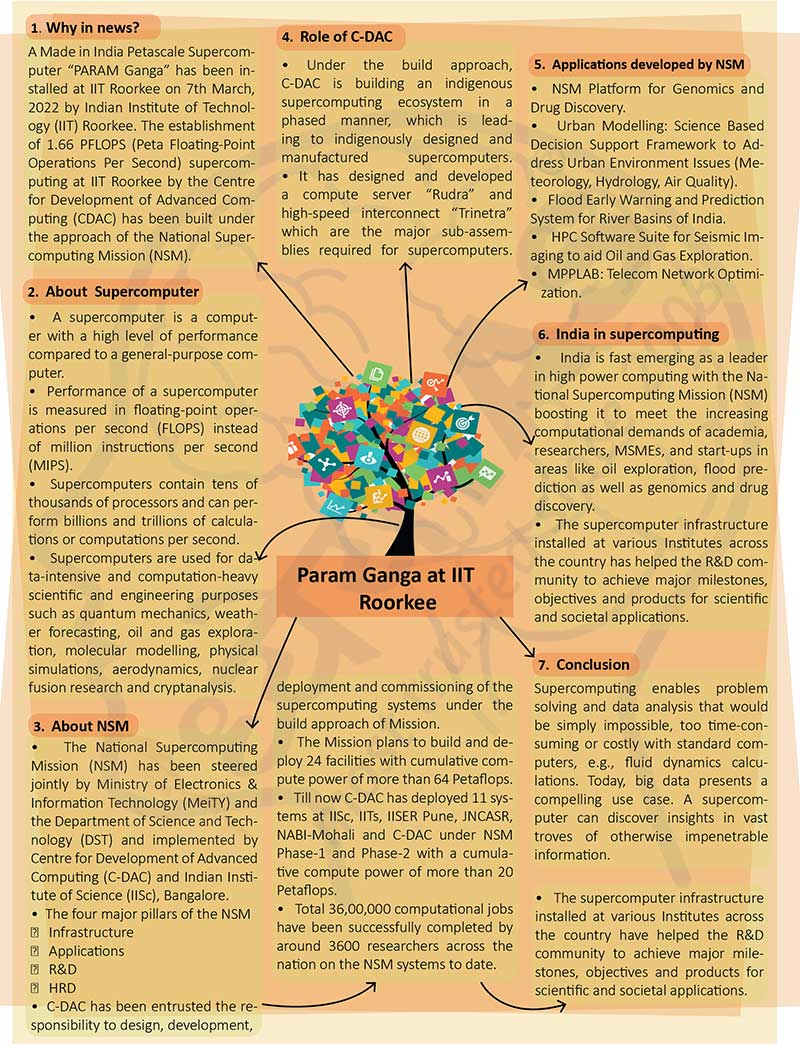Brain-booster
/
14 Apr 2022
Brain Booster for UPSC & State PCS Examination (Topic: Param Ganga at IIT Roorkee)

Why in news?
- A Made in India Petascale Supercomputer “PARAM Ganga” has been installed
at IIT Roorkee on 7th March, 2022 by Indian Institute of Technology (IIT)
Roorkee. The establishment of 1.66 PFLOPS (Peta Floating-Point Operations
Per Second) supercomputing at IIT Roorkee by the Centre for Development of
Advanced Computing (CDAC) has been built under the approach of the National
Supercomputing Mission (NSM).
About Supercomputer
- A supercomputer is a computer with a high level of performance compared
to a general-purpose computer.
- Performance of a supercomputer is measured in floating-point operations
per second (FLOPS) instead of million instructions per second (MIPS).
- Supercomputers contain tens of thousands of processors and can perform
billions and trillions of calculations or computations per second.
- Supercomputers are used for data- intensive and computation-heavy
scientific and engineering purposes such as quantum mechanics, weather
forecasting, oil and gas exploration, molecular modelling, physical
simulations, aerodynamics, nuclear fusion research and cryptanalysis.
About NSM
- The National Supercomputing Mission (NSM) has been steered jointly by
Ministry of Electronics & Information Technology (MeiTY) and the Department
of Science and Technology (DST) and implemented by Centre for Development of
Advanced Computing (C-DAC) and Indian Institute of Science (IISc),
Bangalore.
- The four major pillars of the NSM
- Infrastructure
- Applications
- R&D
- HRD
- C-DAC has been entrusted the responsibility to design, development,
deployment and commissioning of the supercomputing systems under the build
approach of Mission.
- The Mission plans to build and deploy 24 facilities with cumulative
compute power of more than 64 Petaflops.
- Till now C-DAC has deployed 11 systems at IISc, IITs, IISER Pune, JNCASR,
NABI-Mohali and C-DAC under NSM Phase-1 and Phase-2 with a cumulative
compute power of more than 20 Petaflops.
- Total 36,00,000 computational jobs have been successfully completed by
around 3600 researchers across the nation on the NSM systems to date.
- The supercomputer infrastructure installed at various Institutes across
the country have helped the R&D community to achieve major milestones,
objectives and products for scientific and societal applications.
Role of C-DAC
- Under the build approach, C-DAC is building an indigenous supercomputing
ecosystem in a phased manner, which is leading to indigenously designed and
manufactured supercomputers.
- It has designed and developed a compute server “Rudra” and high-speed
interconnect “Trinetra” which are the major sub-assemblies required for
supercomputers.
Applications developed by NSM
- NSM Platform for Genomics and Drug Discovery.
- Urban Modelling: Science Based Decision Support Framework to Address
Urban Environment Issues (Meteorology, Hydrology, Air Quality).
- Flood Early Warning and Prediction System for River Basins of India.
- HPC Software Suite for Seismic Imaging to aid Oil and Gas Exploration.
- MPPLAB: Telecom Network Optimization.
India in supercomputing
- India is fast emerging as a leader in high power computing with the
National Supercomputing Mission (NSM) boosting it to meet the increasing
computational demands of academia, researchers, MSMEs, and start-ups in
areas like oil exploration, flood prediction as well as genomics and drug
discovery.
- The supercomputer infrastructure installed at various Institutes across
the country has helped the R&D community to achieve major milestones,
objectives and products for scientific and societal applications.
Conclusion
- Supercomputing enables problem solving and data analysis that would be
simply impossible, too time-consuming or costly with standard computers,
e.g., fluid dynamics calculations. Today, big data presents a compelling use
case. A supercomputer can discover insights in vast troves of otherwise
impenetrable information.







